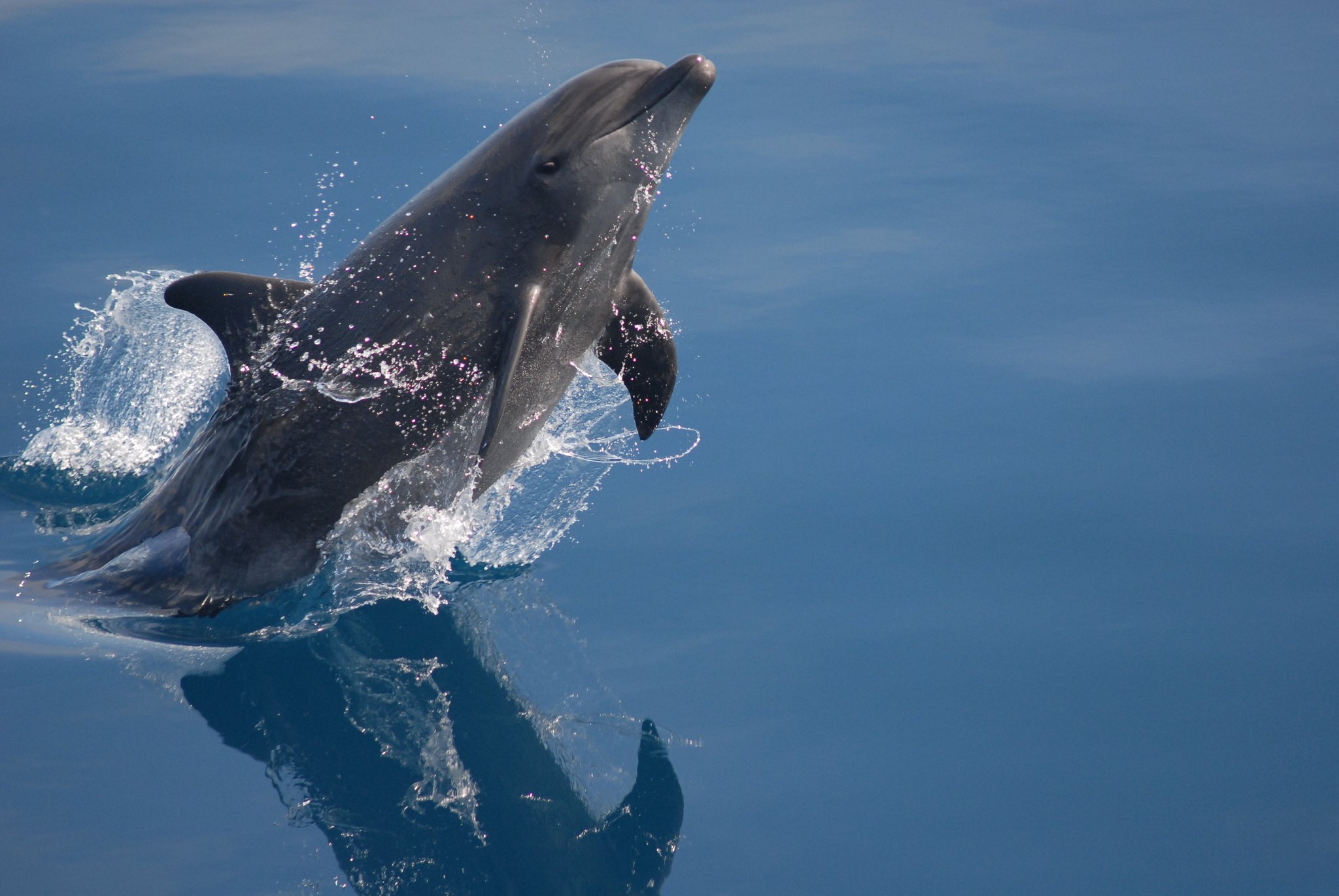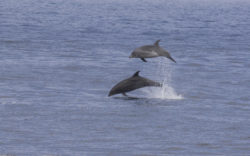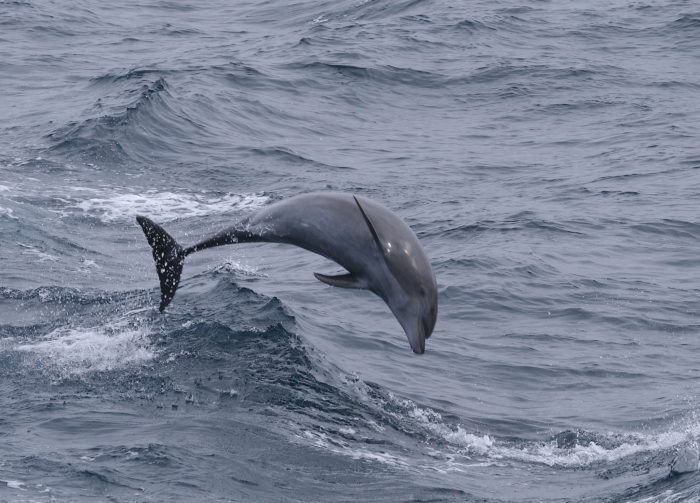
Sea Wonder: Bottlenose Dolphin

A bottlenose dolphin found in Florida Keys National Marine Sanctuary. Photo credit: NOAA
The common bottlenose dolphin (Tursiops truncatus) is one of the world’s most well-known mammals. You might know them for jumping, flipping, and surfing along the wakes of boats, but these aquatic marvels are capable of so much more.
Description
Common bottlenose dolphins look like what you might expect of a dolphin. They are gray, slender, and have a beak-like snout (rostrum) at the front of their bodies. They are one of the most common dolphin species seen in coastal waters worldwide. Males and females don’t tend to differ greatly in size, reaching lengths of about 13 feet and weights of up to 1,400 pounds when fully grown. Their rostrums contain cone-shaped teeth used for grabbing their prey before swallowing it whole. Atop their heads is a single blowhole used for breathing, and the animals need to think about taking a breath every time they reach the surface – it is not an automatic reflex. About midway down their backs are a dorsal fin made of cartilage like our ears and noses, each one unique in its size and shape. The dorsal fin helps the animals stay stable under the water like the rudder of a boat, and the differences in appearance help people tell one dolphin apart from the next. They have two moveable pectoral fins – one on either side of their bodies – a belly button about halfway down their bellies, and a flat tail composed of two fins called flukes, which they pump in an up and down motion to swim. Dolphins have what is called countershading, which means their backs are much darker than their white or pink bellies, a color-scheme that helps them blend into the water depending on where you are looking at them from.
Diet & Habitat

Photo: Gregory Smith
Common bottlenose dolphins are strict carnivores and opportunistic feeders, meaning they eat whatever animals are easiest to find and catch. Their diet is mostly composed of fish, crustaceans, and invertebrates. Oftentimes, bottlenose dolphins hunt cooperatively, whether by blowing bubbles to stun and confuse prey, corralling prey to shallow beaches, or stunning them with fin slaps, jaw pops, and loud vocalizations. To eat, they simply grab prey between their cone-shaped teeth and swallow them whole, Common bottlenose dolphins have few natural predators, but occasionally fall victim to sharks or larger dolphins like orcas.
Common bottlenose dolphins live in coastal waters along tropical, subtropical, and temperate latitudes, including on both of America’s coasts. On the east coast, we see dolphins from New York down to Florida and into the Gulf of Mexico and the Caribbean, and on the west coast we see them from San Francisco south into Mexico. They visit bays, estuaries, and the mouths of rivers and harbors, generally because food is easy to catch there. In America’s National Marine Sanctuary System, we see common bottlenose dolphins in or near Stellwagen Bank, Gray’s Reef, Florida Keys, Flower Garden Banks, Cordell Bank, Greater Farallones, Channel Islands, and Monterey Bay national marine sanctuaries.
Life History
Common bottlenose dolphins are known to be athletic, swimming at top speeds of 18 to 20 miles per hour and being able to launch their bodies nearly 30 feet into the air. However, these activities require a lot of energy, and are rare to see than you might think. Dolphins are psychologically quite active as well, as they are playful, inquisitive, and not afraid to explore. They might play with objects like sea grass, sponges, or other items they find along the way, explore their environments using echolocation (biological sonar) or socialize with one another throughout the day. As active as they are, dolphins still need rest, and they get their ZZZ’s by closing one eye at a time to rest the opposite half of their brain, while the other eye and half of their brain remain active to help the dolphin remember to breathe, swim, and do all the other important dolphin tasks required to survive in the ocean. Dolphins rest each half of their brain for a few minutes at a time all throughout the day.
Females give birth to live young every few years, and calves are born after a 12-month pregnancy. Males and females are not monogamous. Calves are born live, usually tail first, and their umbilical cord breaks as the newborn darts to the surface for its first breath. Calves nurse from their mothers for about two years while they learn to socialize and eat solid foods on their own. In their juvenile years, calves form juvenile pods with individuals similar in age to them and may or may not leave their mother’s group altogether. Other social groups we see in common bottlenose dolphins are maternal pods (multiple adult females and their young, helpful for taking turns watching calves while the mothers go feed), bachelor pods (a group of two or three pair-bonded males that travel together for life), and juvenile pods (a mix of younger male and female dolphins who recently left their maternal pods). Dolphins live in what is called a fission-fusion society, so groups come together and separate, rearranging social groupings and hierarchies regularly.
Common bottlenose dolphins can live into their 50s and 60s, but in the ocean the average lifespan is closer to 25 years old due to threats like bycatch, decreasing food availability, and disease or strandings. In human care settings, several dolphins have lived into their 60s and have allowed us to better understand the life cycle of bottlenose dolphins and conditions they experience as they age.
Threats & Conservation
Common bottlenose dolphins are not considered threatened or endangered, but they could in the future. They are sentinel species that can indicate the health of the ocean, and hint at potential threats to humans related to pollution or other negative events in the ocean. Like all marine mammals in the U.S., common bottlenose dolphins are protected under the Marine Mammal Protection Act of 1972. Their proximity to shore puts them at risk of pollution exposure, habitat degradation, ship-strikes, entanglement, and exposure to noise pollution. High levels of tourism activities in their natural environment can also disturb these animals, their feeding, and social behavior such as reproduction.

Photo: Gregory Smith
